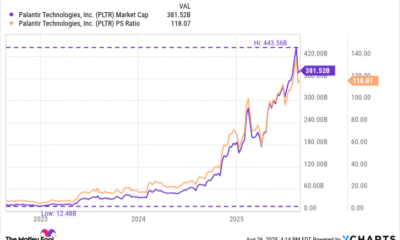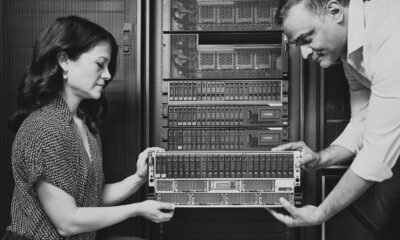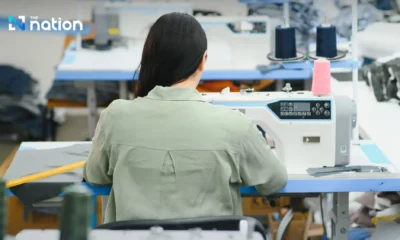Tools & Platforms
AI Is Already Taking Tech Jobs

Since the rise of generative AI, many have feared the toll it would take on the livelihood of human workers. Now CEOs are admitting AI’s impact and layoffs are starting to ramp up.
Between meetings in April, Micha Kaufman, CEO of the freelance marketplace Fiverr, fired off a memo to his 1,200 employees that didn’t mince words: “AI is coming for your jobs. Heck, it’s coming for my job too,” he wrote. “This is a wakeup call.”
The memo detailed Kaufman’s thesis for AI — that it would elevate everyone’s abilities: Easy tasks would become no-brainers. Hard tasks would become easy. Impossible tasks would become merely hard, he posited. And because AI tools are free to use, no one has an advantage. In the shuffle, people who didn’t adapt would be “doomed.”
“I hear the conversation around the office. I hear developers ask each other, ‘Guys, are we going to have a job in two years?’” Kaufman tells Forbes now. “I felt like this needed validation from me — that they aren’t imagining stuff.”
Already, younger and more inexperienced programmers are seeing a drop in employment rate; the total number of employed entry-level developers from ages 18 to 25 has dropped “slightly” since 2022, after the launch of ChatGPT, said Ruyu Chen, a postdoctoral fellow at the Digital Economy Lab of Stanford’s Institute for Human-Centered AI. It isn’t just lack of experience that could make getting a job extremely difficult going forward; Chen notes too that the market may be tougher for those who are just average at their jobs. In the age of AI, only exceptional employees have an edge.
“We’re going from mass hiring to precision hiring,” said Chen, adding that companies are starting to focus more on employing experts in their fields. “The superstar workers are in a better position.”
Chen and her colleagues studied large-scale payroll data in the U.S., shared by the HR company ADP, to examine generative AI’s impact on the workforce. The employment rate decline for entry-level developers is small, but a significant development in the field of engineering in the tech industry, an occupation that has seemed synonymous with wealth and exorbitant salaries for more than a quarter century.
Now suddenly, after years of rhetoric about how AI will augment workers, rather than replace them, many tech CEOs have become more direct about the toll of AI. Anthropic CEO Dario Amodei has said AI could wipe out half of all entry-level white-collar jobs and spike unemployment up to 20% within the next five years. Amazon CEO Andy Jassy said last month that AI will “reduce our total corporate workforce” over the next few years as the company begins to “need fewer people doing some of the jobs that are being done today, and more people doing other types of jobs.” Earlier this year, Shopify CEO Tobi Lutke also posted a memo that he sent his team, saying that budget for new hires would only be granted for jobs that can’t be automated by AI.
Tech companies have also started cutting jobs or freezing hiring explicitly due to AI and automation. At stalwart IBM, hundreds of human resources employees were replaced by AI in May, part of broader job cuts that terminated 8,000 employees. Also in May, Luis von Ahn, CEO of the language learning app Duolingo, said the company would stop using contractors for work that could be done by AI. Sebastian Siemiatkowski, CEO of buy-now-pay-later firm Klarna, said in May that the company had slashed its workforce 40%, in part due to investments in AI.
“We’re going from mass hiring to precision hiring. The superstar workers are in a better position.”
Microsoft made its own waves earlier this month when it laid off 9,000 employees, or about 4% of its workforce. The company didn’t explicitly cite AI as a reason for the downsizing, but it has broadly increased its spending in AI and touted the savings it had racked up from using the tech. Automating customer service at call centers alone, for example, saved more than half a billion dollars, according to Bloomberg. Meanwhile, CEO Satya Nadella said in April that as much as 30% of code at the company is being written by AI. “This is what happens when a company is rearranging priorities,” one laid off Microsoft employee told Forbes.
Microsoft didn’t respond to questions about the reasons behind its layoffs, but said in a statement: “We continue to implement organizational changes necessary to best position the company for success in a dynamic marketplace.”
It’s difficult to pinpoint the exact motivation behind job cuts at any given company. The overall economic environment could also be a factor, marked by uncertainties heightened by President Donald Trump’s erratic tariff plans. Many companies also became bloated during the pandemic, and recent layoffs could still be trying to correct for overhiring.
According to one report released earlier this month by the executive coaching firm Challenger, Gray and Christmas, AI may be more of a scapegoat than a true culprit for layoffs: Of more than 286,000 planned layoffs this year, only 20,000 were related to automation, and of those, only 75 were explicitly attributed to artificial intelligence, the firm found. Plus, it’s challenging to measure productivity gains caused by AI, said Stanford’s Chen, because while not every employee may have AI tools officially at their disposal at work, they do have unauthorized consumer versions that they may be using for their jobs.
While the technology is beginning to take a toll on developers in the tech industry, it’s actually “modestly” created more demand for engineers outside of tech, said Chen. That’s because other sectors, like manufacturing, finance, and healthcare, are adopting AI tools for the first time, so they are adding engineers to their ranks in larger numbers than before, according to her research.
Automating jobs has its limits, too. Last year, Klarna said that the company’s AI tools were doing the work equivalent to 700 customer service agents. But a year later, the company seemed to reverse course, announcing a recruitment drive to hire more human agents.
CEO Siemiatkowski has denied the new hiring push meant the company was pulling back on AI. Instead, he said the new human agents would handle more of the higher-end conversations the company had previously outsourced. Siemiatkowski was not available for an interview, but Klarna spokesperson Clare Nordstrom defended the strategy. “We rely on AI just as much,” she said in a statement. “However, we have noticed that in a world where everything is automated,” she continued, “people put a premium on the human experience.”
Klarna’s experiments show that deciphering which tasks are more suitable for humans, and which can be entrusted to machines, is an open question. Siemiatkowski has been one of the most vocal proponents of automation: to prove the point, when Klarna announced first-quarter earnings in May, he didn’t even show up. Instead, he arranged for an AI deepfake of himself to give the financial update and trumpet a profitable three months.
The upside to the upheaval, Fiverr’s Kaufman said, is that people seem willing to learn. (The company hasn’t done any AI-related layoffs or hiring freezes, he told Forbes.) In his memo to employees, he said he would hold office hours to discuss the changing AI landscape with anyone who wanted to chat. He booked a conference room for 50 people. To his surprise, he showed up to find 250 employees waiting for him.
“So it was just, ‘All right, let’s do this,’” Kaufman said. He told employees they needed to be proactive to learn new AI techniques, and not just wait to be taught. “I’m going to help anyone who is motivated to help themselves.”
More from Forbes
Tools & Platforms
Your browser is not supported
azcentral.com wants to ensure the best experience for all of our readers, so we built our site to take advantage of the latest technology, making it faster and easier to use.
Unfortunately, your browser is not supported. Please download one of these browsers for the best experience on azcentral.com
Tools & Platforms
Maritime Networks Show Boards How To Navigate AI Governance

From Sails to Servers
Solange Charas, PhD, HCMoneyball
When boards grapple with AI governance today, they often feel they’re navigating uncharted waters. But we’ve sailed these seas before. Five centuries ago, maritime networks created the world’s first global information superhighway, transforming how value was created, managed, and measured. The governance lessons from that era offer a strategic blueprint for today’s C-suite leaders managing AI transformation. As Forbes has noted, boards must navigate AI governance in an uncertain regulatory environment, making historical precedents increasingly valuable.
Between 1400 and 1700, maritime innovations didn’t just change transportation—they fundamentally reshaped business models, workforce development, and financial systems. The parallels to today’s AI revolution are striking, and the governance implications are clear: organizations that treat AI as merely a technology deployment will miss the strategic transformation it demands.
The Original Platform Economy: Governance Lessons from Maritime Networks
Modern boards often view AI through the lens of operational efficiency. History suggests this misses the point entirely. The Dutch East India Company (VOC), founded in 1602, understood that maritime technology wasn’t just about better ships—it was about creating entirely new organizational structures.
The VOC pioneered what we’d now recognize as platform governance: standardized global processes, the world’s first modern stock exchange for capital formation, complex multi-continental logistics networks, and hybrid workforce models that mixed employees with contractors. Most importantly, they created compensation structures that aligned individual performance with enterprise returns—paying workers modest wages plus profit shares.
This wasn’t just innovative management; it was strategic governance that recognized foundational technology requires fundamental changes to how organizations create and capture value. Today’s boards face an identical challenge with AI.
Human Capital as Strategic Asset: Then and Now
The maritime revolution created entirely new professional categories that hadn’t existed before: navigators who mastered complex mathematical calculations, cartographers who combined technical precision with creative insight, and insurance underwriters who developed sophisticated risk assessment capabilities.
Traditional roles didn’t disappear—they evolved. Local traders expanded their capabilities to operate globally. Ship captains transitioned from operational roles to complex management positions overseeing intercontinental operations. Craftsmen upskilled to work with new materials and production methods.
The key insight for today’s CHROs and CFOs: successful maritime powers invested systematically in workforce transformation. Spain’s Casa de Contratación created standardized navigator certification programs—perhaps history’s first technical bootcamp. Maritime academies proliferated across Europe, teaching navigation, cartography, and global commerce.
This systematic approach to skills development wasn’t a cost center—it was a strategic investment that enabled competitive advantage. The same principle applies to AI transformation today. As Forbes has highlighted, human capital is the ultimate differentiator in technological transformations.
Financial Governance: Measuring Maritime ROI vs. AI ROI
The governance challenge boards face with AI mirrors what maritime-era leaders confronted: how do you measure returns on transformational technology?
Historical data reveals striking patterns:
- Trade volumes increased tenfold between 1400-1700
- Spice prices in European markets dropped 70% due to transportation efficiency
- Port cities like Amsterdam experienced 400% population growth
- Specialist navigators earned wage premiums of 3-4x typical artisan compensation
Today’s AI metrics show remarkably similar patterns:
- McKinsey reports AI can drive 23% average productivity improvements
- AI specialists command 35-50% wage premiums above traditional technical roles
- Organizations implementing AI systematically see measurable improvements in operational efficiency and revenue growth
The critical governance lesson: early adopters rarely dominate technological revolutions. Systematic adapters do. AI implementation success comes from systematic approaches, not speed. The Portuguese developed superior maritime technology first, but the Dutch built superior organizational systems around that technology and ultimately dominated global trade. AI implementation success comes from systematic approaches not speed!
Three Governance Imperatives for AI Leadership
Maritime history reveals three essential governance principles that apply directly to AI transformation:
1. Ecosystem Investment Over Technology Investment
Maritime success required more than better ships. It demanded navigation schools, financing mechanisms, legal frameworks, and insurance markets. Similarly, successful AI implementation requires governance ecosystems: training programs, ethical frameworks, data infrastructure, and risk management protocols.
Boards must ask: Are we building AI capability or AI ecosystems? The former leads to pilot projects that don’t scale. The latter creates sustainable competitive advantage.
2. Balanced Risk Management
Thriving maritime nations balanced protection of existing industries with incentives for innovation. England’s Navigation Acts protected domestic shipping while encouraging new ventures. Dutch financial innovations managed risk while enabling new business models.
Today’s boards need similar balanced approaches to AI policy. This means establishing governance frameworks that both protect against algorithmic bias and legal exposure while enabling workforce augmentation and operational innovation.
3. Systematic Human Capital Development
The most successful maritime powers created formal institutions for skills development. They recognized that technological advantage comes from human capability, not just technical capability.
CHROs and boards must treat AI literacy as a strategic imperative, not a training afterthought. This means creating systematic development programs, tracking human capital ROI alongside AI ROI, and ensuring that workforce transformation supports rather than undermines organizational resilience.
Measuring What Matters: Human Capital ROI in the AI Era
The SEC’s enhanced human capital disclosure requirements under Reg S-K Item 101(c) reflect growing recognition that workforce strategy is material to enterprise value. Maritime-era governance offers a template: track both technological adoption and human adaptation with equal rigor.
Key metrics should include:
- AI-human collaboration effectiveness, not just automation rates
- Internal mobility and reskilling success rates
- Innovation pipeline strength as AI augments human creativity
- Employee engagement and retention during technological transition
These aren’t “soft” HR metrics—they’re predictive indicators of sustainable competitive advantage.
The Governance Imperative: Leadership in Transformation
History’s lesson is unambiguous: technological revolutions reward systematic adapters, not early adopters. The Portuguese pioneered maritime technology but the Dutch mastered maritime governance.
For today’s boards, this means treating AI not as an IT project but as a governance challenge that spans strategy, finance, and human capital. Success requires CHROs and CFOs working in concert to ensure AI enhances rather than erodes organizational capability.
The organizations that emerge stronger from AI transformation will be those that remember what maritime history teaches: technology alone never changes the world. People, institutions, and governance do.
Author Note: This column builds on collaborative research with Stela Lupushor examining historical patterns in technological transformation and their implications for modern workforce strategy.
Tools & Platforms
Your browser is not supported
northjersey.com wants to ensure the best experience for all of our readers, so we built our site to take advantage of the latest technology, making it faster and easier to use.
Unfortunately, your browser is not supported. Please download one of these browsers for the best experience on northjersey.com
-
Tools & Platforms3 weeks ago
Building Trust in Military AI Starts with Opening the Black Box – War on the Rocks
-

 Business2 days ago
Business2 days agoThe Guardian view on Trump and the Fed: independence is no substitute for accountability | Editorial
-

 Ethics & Policy1 month ago
Ethics & Policy1 month agoSDAIA Supports Saudi Arabia’s Leadership in Shaping Global AI Ethics, Policy, and Research – وكالة الأنباء السعودية
-

 Events & Conferences3 months ago
Events & Conferences3 months agoJourney to 1000 models: Scaling Instagram’s recommendation system
-

 Jobs & Careers2 months ago
Jobs & Careers2 months agoMumbai-based Perplexity Alternative Has 60k+ Users Without Funding
-

 Funding & Business2 months ago
Funding & Business2 months agoKayak and Expedia race to build AI travel agents that turn social posts into itineraries
-

 Education2 months ago
Education2 months agoVEX Robotics launches AI-powered classroom robotics system
-

 Podcasts & Talks2 months ago
Podcasts & Talks2 months agoHappy 4th of July! 🎆 Made with Veo 3 in Gemini
-

 Podcasts & Talks2 months ago
Podcasts & Talks2 months agoOpenAI 🤝 @teamganassi
-

 Mergers & Acquisitions2 months ago
Mergers & Acquisitions2 months agoDonald Trump suggests US government review subsidies to Elon Musk’s companies





















